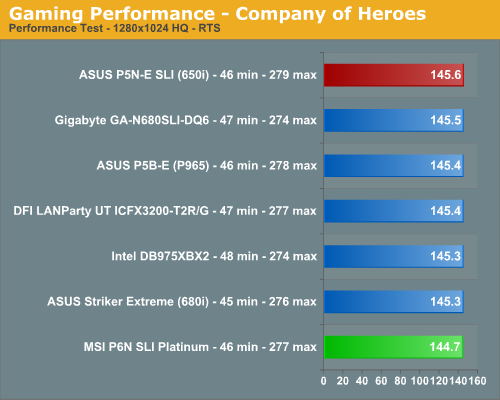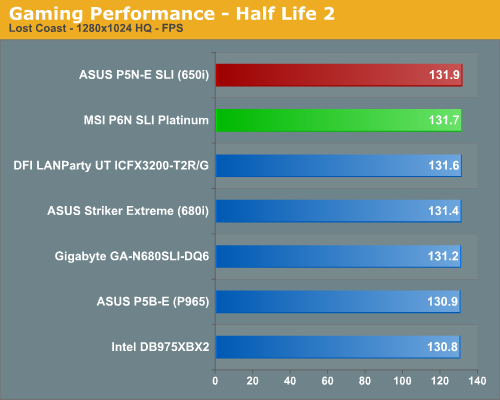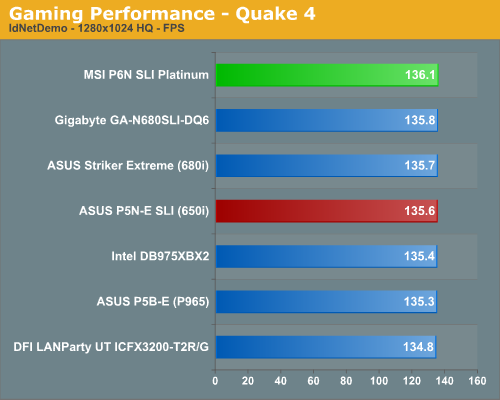MSI P6N SLI Platinum: NVIDIA's 650i Part Two
by Gary Key on March 13, 2007 1:00 AM EST- Posted in
- Motherboards
Standard Gaming Performance
As usual, gaming performance was tested with a variety of current games. We ran benchmarks with our standard 1280x1024 resolution without antialiasing enabled (and generally without anisotropic filtering, though that varies by game). Given the number of users that run 19" LCDs these days, 1280x1024 represents one of the most commonly used resolutions. We could certainly increase the amount of eye candy being displayed in most of the games, but as this is a motherboard benchmark we aren't particularly interested in maxing out the graphics cards in our tests.




It's the same old song and dance but these results basically show that any of the chipsets listed will perform equally in today's games when equipped with the same high-end GPU. Our MSI board wins two benchmarks, finishes a very close second in one, and in the CPU intensive Company of Heroes finishes last - though it is less than a 1 frame per second difference from the top scoring ASUS 650i board. We did not experience any issues during testing or during game play with the MSI board. We generally play over a dozen different games for at least a couple of hours on each board to verify that there are no issues such as overheating, stuttering, or network connectivity problems when playing on-line with a various combination of components.
We will have a full selection of SLI game results along with a couple of new benchmarks in our 680i/650i review. In the meantime, we did not find any noticeable differences in 8800GTX SLI performance between the 680i and 650i chipsets up to 1920x1200 resolution in games. The synthetic benchmarks did show differences up to 6% but for the majority of gamers the differences in SLI performance between the two chipsets is negligible in actual game tests. It is only when you crank up the resolution to 2560x1600 or increase AA/AF settings that the dual x16 PCI Express capability on the 680i performs better than the dual x8 PCI Express setup on 650i, and even then the difference isn't all that great.
As usual, gaming performance was tested with a variety of current games. We ran benchmarks with our standard 1280x1024 resolution without antialiasing enabled (and generally without anisotropic filtering, though that varies by game). Given the number of users that run 19" LCDs these days, 1280x1024 represents one of the most commonly used resolutions. We could certainly increase the amount of eye candy being displayed in most of the games, but as this is a motherboard benchmark we aren't particularly interested in maxing out the graphics cards in our tests.




It's the same old song and dance but these results basically show that any of the chipsets listed will perform equally in today's games when equipped with the same high-end GPU. Our MSI board wins two benchmarks, finishes a very close second in one, and in the CPU intensive Company of Heroes finishes last - though it is less than a 1 frame per second difference from the top scoring ASUS 650i board. We did not experience any issues during testing or during game play with the MSI board. We generally play over a dozen different games for at least a couple of hours on each board to verify that there are no issues such as overheating, stuttering, or network connectivity problems when playing on-line with a various combination of components.
We will have a full selection of SLI game results along with a couple of new benchmarks in our 680i/650i review. In the meantime, we did not find any noticeable differences in 8800GTX SLI performance between the 680i and 650i chipsets up to 1920x1200 resolution in games. The synthetic benchmarks did show differences up to 6% but for the majority of gamers the differences in SLI performance between the two chipsets is negligible in actual game tests. It is only when you crank up the resolution to 2560x1600 or increase AA/AF settings that the dual x16 PCI Express capability on the 680i performs better than the dual x8 PCI Express setup on 650i, and even then the difference isn't all that great.










20 Comments
View All Comments
nicolasb - Tuesday, March 13, 2007 - link
Maybe this was mentioned in part 1 and I missed it, but how does the 650i perform in terms of heat output? And how effective/noisy is the north bridge cooling on the MSI board? And how does the overall power consumption of the system compare to P965? The 680i certainly runs very hot indeed compared to its Intel rivals;I think need to know if the 650i does the same.Gary Key - Tuesday, March 13, 2007 - link
Power consumption numbers are on page 9. Thermals are a different story as they will vary widely depending upon the case design and internal cooling. The best I can do is to setup a 650i and a P965 on a test platform and take readings without any airflow across the boards. I will do that tonight but from the touch of your finger testing, I figure the 650i is about 15% warmer on average. The fan that MSI includes has a db rating of 34 and did not sound whiny in testing.nicolasb - Tuesday, March 13, 2007 - link
I think we need to know, even.Geraldo8022 - Tuesday, March 13, 2007 - link
Yes, this is very important to me and I also would like the answers to these questions.phusg - Tuesday, March 13, 2007 - link
Guys I agree it's very important but please RTFA first ;-)From page 9 power consumption you can conclude that the 650i uses some 10-15 Watts less than the 690i.
phusg - Tuesday, March 13, 2007 - link
Additionally if idle is more important to you then the P965 seems to nose in front, if load is more important then the RD600 chipset seems to be king. Unfortunately only DFI has a board at the moment although I think ASUS is rumoured to be preparing one too.And as far as noise goes I think all these motherboards are passively cooled, so they should be pretty close to 0db.
yyrkoon - Tuesday, March 13, 2007 - link
First, let me get this out of the way:Last page second to the last paragraph, I'm assuming you meant 'knock-out blow' ?
Now that, that is out of the way, is it just me, or does it seem that MSI is/has been encroaching on ABIT, and like companies as far as stability goes ? I personaly have not owned any MSI motherboards for quite some time, but everytime I read about their boards, it seems to be getting more, and more favorable for them.
Now a question concerning functionality. Will this SIL eSATA chip handle SATA Port multipliers well ? Would be a very good option if so. Also how many PCIE lanes do these boards actually use vs the i680 boards ? I remember seeing a spec sheet of the 590 vs the 570 (which if I recall correctly, was half the PCIE lanes, 590 vs 570 that is) but I do not recall seeing any data concerning the i680 vs its little breathren.
Gary Key - Tuesday, March 13, 2007 - link
Hi,It should have been knock-out blow and is corrected now. On the front page we linked to our 680i launch article that explained the technical differences between the chipsets - http://www.anandtech.com/cpuchipsets/showdoc.aspx?...">680i Launch - but to answer your question quickly the 680i has 46 PCI Express Lanes and nine links compared to 18 PCI Express Lanes and four links on the 650i SLI. The specs on the SIL3531 can be found here - http://www.siliconimage.com/products/product.aspx?...">SiL3531. The chipset has support for Port Multipliers with FIS-based switching such as their own SiL3726 chipset.
MSI over the last couple of years had lost their focus to some degree in the motherboard market and it seemed as though they either wanted to product low cost boards to compete against ECS/Foxconn or high-end boards in their Diamond series. You never knew what to expect from them when a new chipset was released. They were also getting a bad rap for being late to market along with getting the board finally tuned correctly about the time production ended on it. I know from several discussions with them over the past couple of months that they are aware of past issues and are vigorously working to correct those issues now. Product quality has always been good overall but has certainly become better as of late while pricing is still aggressive based upon feature sets.
Thanks for the comments.
yyrkoon - Tuesday, March 13, 2007 - link
Thanks for the reply Gary.Am I right in assuming that just because a given chipset has x mount of PCIE lanes/Links, that <insert OEM> motherboard manufactuer is not obligated in using all of these lanes /links ? IF this be the case, how would one go about finding this information out, without reverse engineering the motherboard ?
just4U - Wednesday, March 21, 2007 - link
Odd is it not? They used to be first to market in alot of boards and had to constantly fine tune after launch because they were riddled with issues. I've always liked MSI and usually purchase a few of their boards each year.